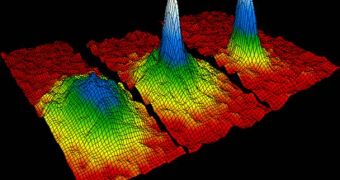Researchers at the Israel Institute of Technology (IIT) have managed to create a sonic black hole, a device based on Einstein-Bose condensates that is able to trap sound waves, basically acting in very much the same way a cosmic black hole does when absorbing visible light from the electromagnetic spectrum. The device was made of two clouds of rubidium 87 atoms, cooled close to absolute zero, at just 50 nano Kelvins, and separated by a tiny gap.
“It's like a black hole because waves get sucked in and can't escape. But in this case we use sound waves instead of light,” IIT scientist Jeff Steinhauer, who is also the corresponding author of a new paper detailing the achievement, published on the ArXiv pre-print Web page, explained. Discovery News informs that the gap between the two atomic clouds, known as “density inversion,” is the key to the entire sonic black hole. Between the two clouds, the small area has an extremely low density, which allows atoms to pass from one cloud to the other almost unimpeded.
The rubidium 87 atoms do that at a very high speed, of almost three millimeters per second, which, to scale, is about four times faster than the speed of sound, or 343 meters (1,125 feet) per second. The expert also pinpointed that the atom clouds actually behaved differently from the atmospheric clouds. While the clouds in the sky are lighter than the air underneath, and thus remain afloat, the atomic clouds are, in fact, denser than the space below them.
This means that a sound wave traveling between the two clouds will gradually fall farther and farther away from the atoms that travel between the two formations as well, on account of the fact that the atoms move four times faster than the sound waves. Essentially, the sounds trying to escape will never have enough speed to escape this vicious circle, and will trail the atoms in a never-ending cycle, thus remaining trapped within the sonic black hole.
“It's like trying to swim slowly against a fast current. The sound waves fall behind because the current is moving faster than the waves,” Steinhauer added. “Jeff's experiment confirms that it really is possible to create a reasonably stable supersonic flow in a superfluid gas. [The study] will give us a new perspective on some really deep issues involving quantum mechanics, thermodynamics and gravity,” Professor James Anglin, from the Technische Universitat Kaiserslautern in Germany, shared.

 14 DAY TRIAL //
14 DAY TRIAL //